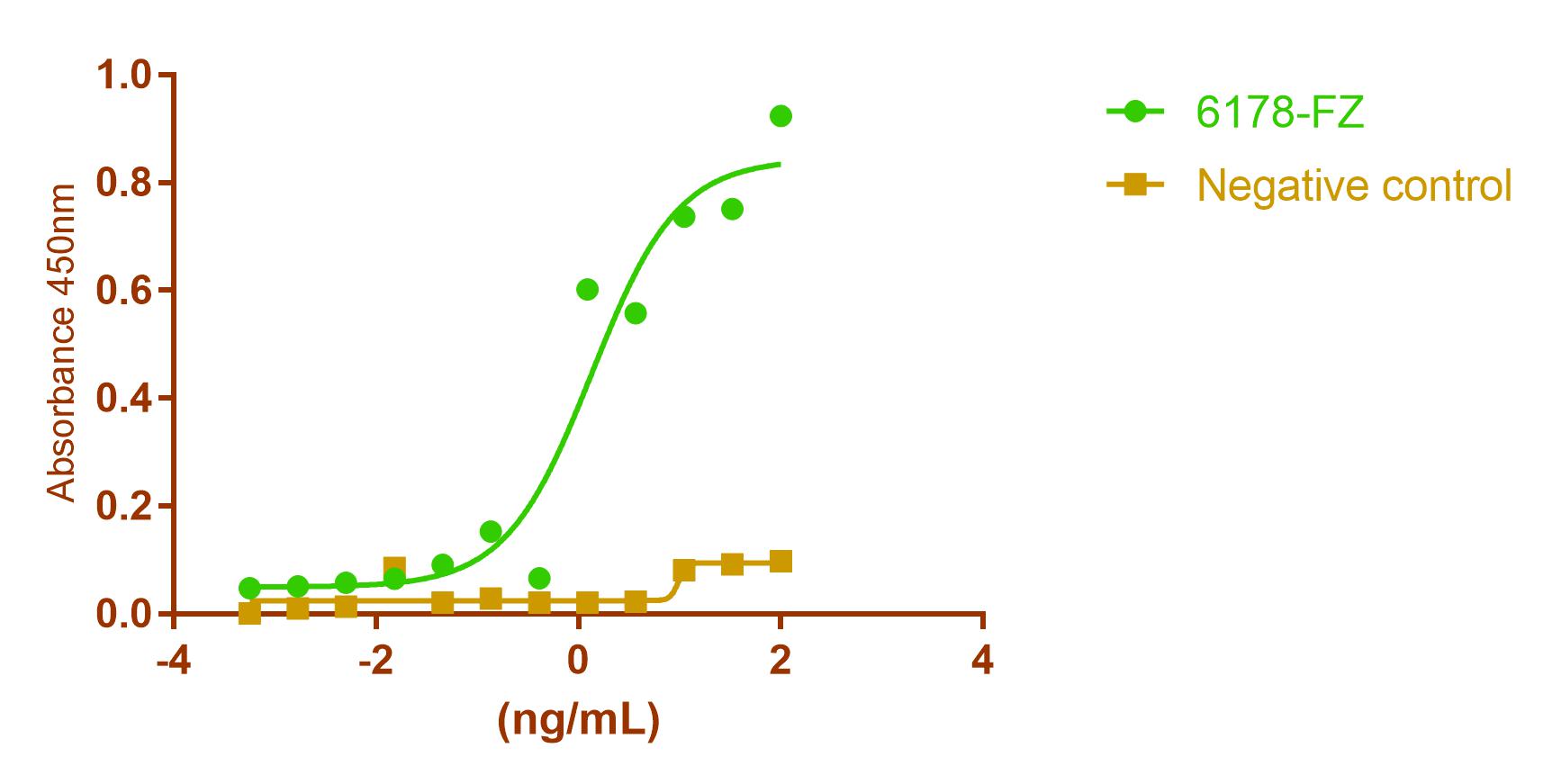| Reactivity | HuSpecies Glossary |
| Applications | Bioactivity |
| Format | Carrier-Free |
| Details of Functionality | Measured by its binding ability in a functional ELISA. In a 100 µL reaction mixture containing biotinylated rmWnt-5a at 100 ng/mL and rhFrizzled-7/Fc Chimera dilutions at 0.1-8,000 ng/mL, the concentration of rhFrizzled-7/Fc Chimera that produces 50% of the optimal binding response is found to be approximately 20-80 ng/mL. Optimal concentrations should be determined by each laboratory for each application. |
||||||
| Source | Chinese Hamster Ovary cell line, CHO-derived human Frizzled-7 protein
|
||||||
| Accession # | |||||||
| N-terminal Sequence | Gln33 |
||||||
| Structure / Form | Disulfide-linked homodimer |
||||||
| Protein/Peptide Type | Recombinant Proteins |
||||||
| Gene | FZD7 |
||||||
| Purity | >95%, by SDS-PAGE visualized with Silver Staining and quantitative densitometry by Coomassie® Blue Staining. |
||||||
| Endotoxin Note | <0.10 EU per 1 μg of the protein by the LAL method. |
| Dilutions |
|
|
| Theoretical MW | 43.3 kDa (monomer). Disclaimer note: The observed molecular weight of the protein may vary from the listed predicted molecular weight due to post translational modifications, post translation cleavages, relative charges, and other experimental factors. |
|
| SDS-PAGE | 55-66 kDa, reducing conditions |
|
| Reviewed Applications |
|
|
| Publications |
|
| Storage | Use a manual defrost freezer and avoid repeated freeze-thaw cycles.
|
| Buffer | Lyophilized from a 0.2 μm filtered solution in PBS. |
| Purity | >95%, by SDS-PAGE visualized with Silver Staining and quantitative densitometry by Coomassie® Blue Staining. |
| Reconstitution Instructions | Reconstitute at 200 μg/mL in PBS. |
Frizzled-7 is a member of the Frizzled family of unconventional G-protein-coupled glycoprotein receptors for the Wnt signaling pathway (1 - 3). The Wnt genes encode a large family of glycoproteins that are essential in development and tissue maintenance (1, 2). Like other Frizzled family members, Frizzled-7 contains a divergent N-terminal signal peptide (amino acid (aa) 1 - 32), a highly conserved extracellular cysteine-rich domain (CRD, aa 44 - 169), a variable-length linker region (aa 170 ‑ 256), a seven-pass transmembrane region (aa 257 - 549), and a variable-length C-terminal cytoplasmic domain (aa 550 - 574) (1 - 3). The CRD, which comprises the binding site for Wnts and other ligands such as Syndecan 4 and fibronectin, spans about 130 amino acid residues and contains ten invariant cysteine residues (2, 3). Expressed alone, it can compete with native Frizzled to inhibit Wnt canonical signaling (4). Within aa 33 - 185, human Frizzled-7 shares ~99% aa identity with human, rat, canine and bovine Frizzled-7. Mature Frizzled-7 also shares 80% aa identity with Frizzled-1 and Frizzled-2. Roles for Frizzled-7 have been determined in both canonical Wnt/ beta -Catenin-mediated signaling and non‑canonical planar cell polarity and calcium pathways (1, 2, 4). During development, Frizzled-7 is expressed during gastrulation and in the fetal gut, kidney and lung where it is thought to influence tissue morphogenesis via non-canonical signaling pathways (3 - 5). In the adult, Frizzled-7 is expressed in skeletal muscle, especially in satellite cells that mediate muscle regeneration in response to Wnt-7a (3, 6). It is expressed in embryonic stem cells (ES), contributing to self-renewal signaling (7). It has been implicated in mesenchymal-to-epithelial transition in colorectal cancer (2, 8). Frizzled-7 mRNA has also been detected in adult heart and placenta (3).
| Images | Ratings | Applications | Species | Date | Details | ||||
|---|---|---|---|---|---|---|---|---|---|

Enlarge |
reviewed by:
Neha Arora |
Immunoassay Standard | 02/16/2018 |
Summary
|
The concentration calculator allows you to quickly calculate the volume, mass or concentration of your vial. Simply enter your mass, volume, or concentration values for your reagent and the calculator will determine the rest.